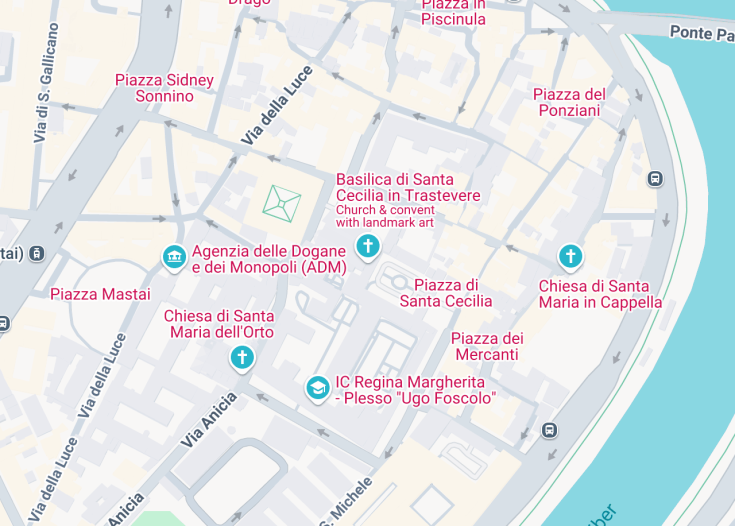The Basilica di Santa Cecilia in Trastevere is a revered basilica located in the heart of Rome’s Trastevere district. This architectural gem, dedicated to Saint Cecilia, is both a historical landmark and a vibrant center for worship within the Catholic faith. Its rich history, dating back to the early fifth century, includes poignant legends and exquisite artistic treasures, making it a significant pilgrimage site for visitors and a must-see for those interested in Roman culture and spirituality.
Visitors are encouraged to explore the basilica’s stunning mosaics and the remarkable statue of Saint Cecilia crafted by Stefano Maderno. Allocate time to fully appreciate the intricate details of the church’s architecture and artistry that reflect its long-standing heritage.
Plan your visit to coincide with one of the liturgical celebrations held at the basilica. Attending a mass can offer a profound experience, as the church resonates with the echoes of centuries of devotion, enhancing your appreciation of this historic site.
Basilica di Santa Cecilia in Trastevere: An Architectural Marvel
The Basilica di Santa Cecilia in Trastevere is a remarkable example of Late Romanesque architecture, characterized by its classic basilical structure featuring a central nave flanked by side aisles. The prominent twelve columns, each capped with intricately designed capitals, connect the arches that support the ceiling, showcasing traditional Roman engineering. The semicircular apse, adorned with a stunning mosaic, reflects the artistic depth of the Early Christian period, encapsulating both theological significance and aesthetic appeal.
Notably, the basilica underwent extensive renovations in subsequent centuries, leading to a Baroque interior enriched with ornamental stuccos and frescoes. The high altar, redesigned during the 17th century, displays a striking marble statue of Santa Cecilia, created by Stefano Maderno, which vividly conveys the saint’s martyrdom. The octagonal ciborium within the sanctuary is another focal point, embodying the transitional architectural style of the period.
In addition to its architectural grandeur, the basilica boasts a rich historical narrative that intertwines with Roman cultural heritage. Papal influences, such as those from Pasquale I, are visible throughout the structure, with renovations commissioned under various popes reflecting the changing artistic trends of their times. The site serves as both a place of worship and a testament to the resilience of Christian art and architecture throughout the centuries.
History
5th to 8th Century
The initial establishment of the Titulus Caeciliae can be traced back to the 5th century, signifying a place of worship dedicated to Saint Cecilia. It is believed that the church was erected on the site of her residence, where she allegedly suffered martyrdom around 220 AD. The early 9th century saw the church gain prominence as Pope Paschal I converted it into a basilica. During this period, Cecilia’s remains were transferred to the new structure, solidifying her legacy within the Christian community.
9th to 12th Century
The 9th century marked significant developments; Pope Paschal I not only constructed the basilica but also initiated the collection of relics, enhancing its status as a spiritual center. The campanile, constructed in the 12th century, remains an architectural highlight, symbolizing the evolving Roman architectural landscape of the time. Moreover, during the late Middle Ages, the church became a focal point for the arts, gaining recognition for Pietro Cavallini’s artistic contributions, notably his frescoes depicting the Last Judgment.
17th to 19th Century
The 17th century witnessed extensive renovations directed by Cardinal Francesco Acquaviva d’Aragona, leading to the grandiose façade that is seen today. Renovations continued through the 18th century with intricate embellishments, but the structural integrity was later addressed in the 19th century with additional consolidation efforts. These transformations reflect a persistent commitment to preserving the church’s heritage while adapting to contemporary needs.
Exploring the Interior and Surroundings of Basilica di Santa Cecilia in Trastevere
Visitors can explore the interior of the basilica, which houses a remarkable array of artistic treasures. The walls are adorned with various frescoes and mosaics that narrate biblical stories, creating an immersive experience of Rome’s religious history. In addition, the accompanying monastery provides tranquil gardens, offering a serene ambiance for contemplation.
The Discovery of Cecilia’s Remains
In 1599, the excavation of Cecilia’s tomb revealed her remarkably preserved body, leading to widespread acclaim for its miraculous nature. The discovery confirmed her status as a martyr and provided pivotal insights into early Christian burial practices. This event remains a significant part of the basilica’s narrative, symbolizing the connection between faith and history in Rome.
General informations
Location
The Basilica di Santa Cecilia in Trastevere is nestled in the charming Trastevere neighborhood of Rome, surrounded by vibrant streets filled with restaurants and shops. It is easily accessible via public transport, making it an inviting spot for visitors to immerse themselves in history.
Address:
Piazza di Santa Cecilia, 22, 00153 Roma RM, ItalyVisiting Information
The basilica is open to the public, allowing visitors to explore its stunning architecture and historical significance at their leisure. It is best to visit early in the morning or late afternoon to enjoy a quieter experience.
How to reach Basilica di Santa Cecilia in Trastevere
Car
The Basilica di Santa Cecilia in Trastevere can be easily reached by car. Parking is available nearby for a nominal fee.
| Route | Distance | Travel time |
|---|---|---|
| From Termini Station | 2.5 miles (4 Km) | 15 minutes |
| From Vatican City | 2 miles (3 Km) | 10 minutes |
| From Fiumicino Airport | 18 miles (29 Km) | 40 minutes |
Public Transport
Basilica di Santa Cecilia in Trastevere is accessible using Rome’s public transport system. The bus and tram services are reliable options for getting to the basilica from various city points.
| Route | Time from City Center |
|---|---|
| From Termini Station (Bus H) | 25 minutes |
| From Vatican City (Tram 8) | 20 minutes |
Accessibility and Limitations
The Basilica di Santa Cecilia in Trastevere offers accessibility features for all visitors, although certain areas may have limitations.
Accessibility
Limitations
- Some areas may have restrictions due to ongoing restoration work.
- Limited seating may affect visitors who need to rest during their visit.
- Guided tours may have group size limitations.
Notes to visitors
- Photography is allowed in most parts of the basilica, but please be respectful of prayer areas.
- Food and drink are not permitted inside the basilica.
- It’s advisable to dress modestly when visiting.
Common questions
What architectural styles are represented in Basilica di Santa Cecilia in Trastevere?
The Basilica di Santa Cecilia in Trastevere features a rich tapestry of architectural styles that reflect its long history and various renovations. Initially built in the late Ancient Roman period, its structure showcases elements of Late Romanesque architecture, particularly in the nave and apse. The basilica’s layout as a classic basilica comprises a central nave flanked by aisles, supported by columns with arches.
Over the centuries, significant changes were made, especially during the Baroque period in the 17th and 18th centuries. The interior was embellished with ornate decorations, including stuccos and frescoes. The facade, designed by Ferdinando Fuga in the early 18th century, displays Baroque characteristics with its grand entrance and intricate detailing. The blend of styles in the basilica creates a fascinating visual experience, from the simplicity of the ancient structure to the opulence of the Baroque enhancements.
What are the significant artworks and features inside the Basilica di Santa Cecilia in Trastevere?
Inside the Basilica di Santa Cecilia in Trastevere, visitors can marvel at various significant artworks and architectural features that highlight the church’s artistic heritage. One of the most notable pieces is the statue of Saint Cecilia, crafted by the famous sculptor Stefano Maderno. This exquisite marble sculpture depicts the saint as she was found, lying in a position that reflects her martyrdom.
Additionally, the basilica houses a stunning array of mosaics, particularly in the apse, which features a beautiful depiction of Christ with Saints Cecilia and Valerian. The intricate details and vibrant colors capture the spirit of early Christian art. The ciborium, or altar canopy, designed by Arnolfo di Cambio in the 13th century, also showcases elaborate decorative work.
The church’s interior, adorned with Baroque elements, includes frescoes by artists such as Sebastiano Conca, enhancing the ambiance with their rich narratives and colors. The combination of these artworks and architectural elements makes the basilica a treasure trove of art and history, attracting art lovers and tourists alike.
Is photography allowed inside the Basilica di Santa Cecilia in Trastevere?
Photography policies at the Basilica di Santa Cecilia in Trastevere can vary, so it’s advisable to check for any specific regulations upon your visit. Generally, visitors are allowed to take photos inside the basilica; however, it’s important to do so respectfully and without disturbing other worshippers or guests.
When capturing images, you should be aware of the prevailing atmosphere, as the basilica is still an active place of worship. Avoid using flash, as it can be disruptive and may potentially damage the artworks over time. If you plan to visit during a service, it’s best to refrain from taking photos altogether.
Always be mindful of any posted signs regarding photography, and consider asking a staff member if unsure about the specific rules during your visit. Overall, as long as you respect the sacred nature of the space, you should be able to capture the beauty of this iconic Roman basilica.
Are there any notable events or traditions associated with Basilica di Santa Cecilia in Trastevere?
The Basilica di Santa Cecilia in Trastevere is not only renowned for its architectural beauty and artworks but also for hosting several notable events and traditions throughout the year. One of the most significant events is the feast day of Saint Cecilia on November 22, which is celebrated with special masses and ceremonies within the basilica. This day honors the patroness of musicians, reflecting her deep connection to music.
The basilica often features musical performances, especially during liturgical celebrations. The church’s historical association with music also continues today, as it serves as a venue for concerts and recitals, thanks to its beautiful acoustics and rich history.
Another tradition involves the annual commemoration of the dedication of the church, which includes ceremonies and events that attract both locals and tourists alike. Visitors can experience the vibrant community life centered around this ancient place of worship, making it more than just a site of architectural significance.
What is the significance of the crypt beneath Basilica di Santa Cecilia in Trastevere?
The crypt beneath the Basilica di Santa Cecilia in Trastevere holds deep historical and spiritual significance, as it is said to contain the remains of Saint Cecilia herself. This sacred space is where many pilgrims and visitors pay their respects to the esteemed martyr. The crypt was reconstructed in the early 20th century and features notable archaeological findings, including remnants of ancient Roman structures.
It also includes a small baptismal area, which highlights the site’s importance in early Christian practices. The atmosphere within the crypt is one of reverence, as it serves as a tangible connection to the past and the legacy of Saint Cecilia. In addition to the saint’s remains, the crypt presents a unique opportunity for visitors to witness the layers of history that span centuries, from the time of Roman habitation through the evolution of Christian worship.
The presence of the crypt adds another layer of depth to the experience of visiting the Basilica di Santa Cecilia, inviting self-reflection and appreciation for the enduring faith that has inspired generations.

Is the Basilica di Santa Cecilia in Trastevere worth visiting in Rome, Italy?
The Basilica di Santa Cecilia in Trastevere is definitely worth visiting when in Rome. This stunning church, with its roots tracing back to the 5th century, offers a glimpse into the city’s rich history and architectural evolution. Visitors are captivated by its beautiful mosaics and the renowned sculpture of Saint Cecilia, which adds to the church’s artistic significance. Beyond its visual appeal, the basilica also has an intriguing story connected to the beloved saint, making it a cultural treasure. The peaceful ambiance serves as a perfect contrast to the bustling city, allowing for quiet reflection. Whether you’re an art lover, a history enthusiast, or simply seeking a serene spot, this basilica promises a rewarding experience in the heart of Rome.










